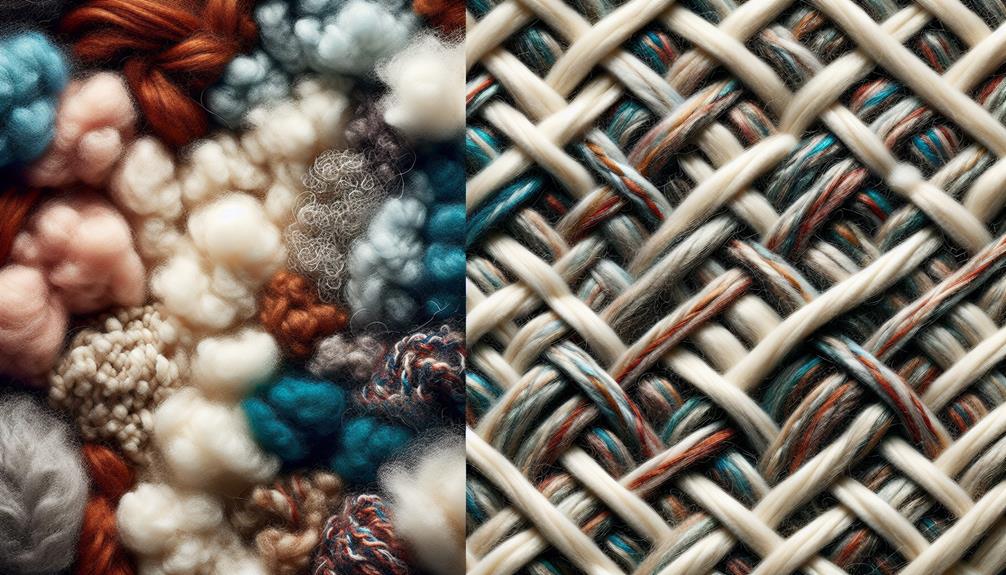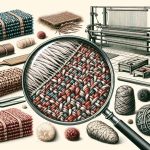I've always found the distinction between wool and tweed pretty fascinating, especially when you start exploring how they're used in fashion. Wool, as you might know, is the soft, curly hair obtained from sheep and other animals, renowned for its warmth and versatility. Tweed, though, is a type of wool, but it's woven to create a thicker, more textured fabric perfect for those durable, stylish jackets and coats we see. What really grabs my attention is how each material serves different purposes and styles, depending on their texture and weave. Curious about which fabric might be best for your next winter outfit or stylish blazer? Let's explore some intriguing specifics that highlight their unique properties and uses.
Table of Contents
Key Takeaways
- Wool is a natural fiber obtained from animals like sheep, while tweed is a type of fabric made from woven wool.
- Tweed is specifically known for its complex weave patterns and textures, unlike plain wool fabrics.
- Wool fibers can vary in softness and are used in different textiles, whereas tweed is typically coarser and used for durable clothing.
- Tweed garments offer structured draping due to the robust nature of the weave, contrasting with the varying drapes of wool garments based on fiber softness.
- Wool is used in a variety of textiles, while tweed is particularly associated with traditional Scottish attire and modern fashion staples.
Understanding Wool and Its Sources
Wool, a natural fiber harvested from animals like sheep, goats, and even rabbits, serves as a versatile and essential material in textile production. Diving into the world of sheep breeds, you'll find a fascinating variety of fibers. Each breed offers distinct wool characteristics that cater to specific needs in textiles. For instance, Merino sheep are renowned for their fine, soft wool that's perfect for clothing directly in contact with the skin, while the coarser wool of the Scottish Blackface is ideal for durable, heavier garments.
Now, let's touch on wool allergies, an important consideration for many. It's a misconception that wool allergies are common. In reality, what some people experience as an allergy is usually a sensitivity to the coarser fibers which can irritate the skin, causing discomfort. True wool allergies are rare and are a reaction to the proteins in the wool, not the fiber itself.
Understanding these nuances not only helps in selecting the right wool for your project but also in addressing concerns about allergies, ensuring that everyone can enjoy the benefits of this incredible natural resource without discomfort.
Exploring the Origins of Tweed
Let's kick things off by looking at how tweed came to be.
We'll touch on where it started, who were the pioneers, and how they shaped its journey.
It's quite the story, starting from humble beginnings to becoming a global icon.
Tweed's Historical Beginnings
Delving into the origins of tweed, it first emerged in Scotland during the 18th century. Initially, this fabric symbolized the rugged, rural life of the Scottish, embodying a sense of practicality and resilience.
Over time, tweed's symbolism evolved greatly. It shifted from being merely practical attire to a staple in fashion circles, marking its importance in fashion evolution.
As tweed became popular among the British aristocracy, it began to represent a fusion of style and durability, making an indelible mark on fashion trends.
This transformation wasn't just about aesthetics; it mirrored broader societal changes, reflecting shifts in social classes and lifestyles. Tweed's adaptability ensured its survival and relevance in a rapidly changing world.
Geographic Roots of Tweed
Tweed's story begins on the misty isles and rugged highlands of Scotland, where its unique weaving techniques first took root. The fabric's geographic origins are deeply intertwined with its cultural identity, influencing both traditional and modern tweed production. The local sheep, climate, and artisan skills in Scotland have all shaped tweed into what it's today.
- Misty Isles: Imagine cool, damp fog enveloping small, scattered islands—perfect for the slow development of dense, warm fabrics.
- Rugged Highlands: Visualize steep, harsh landscapes with hardy sheep breeds whose wool is ideal for durable tweed.
- Artisan Weavers: Think of skilled craftsmen meticulously working looms, a tradition preserved even in today's modern tweed production.
Despite modern advancements and the reduction of tweed tariffs, these elements remain at the heart of tweed's enduring appeal.
Key Figures in Tweed
Exploring the origins of tweed, key figures like the Harris family stand out for their pivotal roles in its development. They weren't just crafters; they were innovators who helped mold the identity of tweed in the fashion world. It's fascinating how their influence extends beyond mere fabric production to shaping the careers of many tweed designers in a meaningful way. These designers, in turn, leveraged the unique qualities of tweed to make a lasting fashion impact, transforming traditional attire into modern, stylish statements.
Delving deeper, the contributions of such families highlight the close-knit relationship between local craftsmanship and global fashion trends. It's a reflection of how important individual and familial contributions have been in elevating tweed from a local craft to a worldwide wardrobe staple.
Different Types of Wool
Now, let's talk about the different types of wool and how they're processed.
I'll explain the various wool varieties and give you a rundown on the techniques used to turn raw fleece into the wool we use.
This covers everything from shearing to spinning, so you get the full picture.
Wool Varieties Explained
While wool is a popular fabric, it's important to understand that there are several types, each with unique characteristics and uses. The variety stems largely from different sheep breeds and the fiber diameter of their wool, which affects the texture and quality.
To paint a clearer picture, consider these vivid examples:
- *Merino Wool*: Sourced from Merino sheep, known for its ultra-fine fibers that create soft, luxuriously gentle textures against the skin.
- *Shetland Wool*: Comes from Shetland sheep, offering a coarser feel, ideal for durable, warm sweaters.
- *Cashmere Wool*: Although technically from goats, it's often categorized with wools, providing a supremely soft and insulating experience despite its light weight.
Each type serves distinct purposes, driven by its unique properties.
Wool Processing Techniques
To comprehend how wool transforms from raw fleece to fabric, we must explore various processing techniques. Initially, fiber selection is important; different sheep breeds produce varying qualities of wool, influencing the end product's texture and durability. After selecting the appropriate fibers, they're cleaned to remove impurities. Next, the fibers undergo carding and spinning, turning them into yarn.
Now, dyeing methods come into play. Options range from natural dyes, which offer unique, earthy tones, to synthetic ones that provide vibrant colors and consistency. Each choice affects the wool's final appearance and feel. This meticulous process ensures that the wool not only meets aesthetic standards but also performs well in both everyday use and artistic applications.
How Tweed Is Made
Tweed production begins with sourcing and dyeing local wool. I'm going to walk you through the fascinating process that transforms this wool into the durable, distinct fabric that we're familiar with as tweed. The journey starts in traditional tweed production locales like the Scottish Isles, where the climate and landscape contribute uniquely to the wool's characteristics.
Once the wool is sourced, it's dyed using a variety of methods. These can range from natural dyes derived from local plants to more modern chemical dyes, allowing for a broad spectrum of vibrant colors. The dyed wool is then blended to create intricate patterns and hues.
The wool is carded and spun into yarn, which is where modern tweed innovations come into play. Advances in spinning technology allow for tighter, stronger yarn, enhancing the fabric's durability and texture.
*Imagine the rhythmic sound of spinning wheels melding fibers into yarn*
*Visualize skilled artisans meticulously setting up traditional looms*
*Feel the transformation as the yarn weaves into the robust, patterned tweed*
This combination of traditional techniques and modern technology guarantees that tweed remains both a cultural heritage and a contemporary fashion choice, appealing to a global audience with its timeless yet adaptable style.
Textural Differences
Let's talk about how wool and tweed feel different to the touch.
Wool tends to be softer, which is great for comfort, while tweed's complex weave gives it a more textured feel.
These differences not only affect how they feel but also how you might wear them.
Wool Softness Vs. Coarseness
Exploring the textural differences, wool varies from soft to coarse, greatly impacting its feel and uses. The softness or coarseness of wool affects how it's used in garments and how comfortable it feels against the skin.
Coarser wools, often sturdier, are excellent for outerwear, offering better temperature regulation during colder months. Meanwhile, softer wools, like Merino, are preferred for clothing that directly touches the skin due to their gentle touch and reduced risk of wool allergies.
- Imagine wrapping yourself in a Merino wool scarf, soft as a cloud against your skin, keeping you cozy without itchiness.
- Visualize a rugged tweed jacket made from coarse wool, robust enough to block the biting wind.
- Think of a soft woolen blanket enveloping you, warmth without the weight.
Tweed Weave Complexity
Diving into the intricacies of tweed, its weave complexity stands out, showcasing a variety of patterns and textures that greatly influence its durability and aesthetic appeal.
The distinct weaving techniques involve intricate fiber interactions that create the unique feel of tweed. By intertwining different types of threads, tweed achieves a depth of texture not commonly found in simpler fabrics. This isn't just about mixing colors; it's about how each fiber type reacts and intertwines with others, affecting the overall resilience and look of the fabric.
These interactions can lead to patterns like herringbone, check, or plaid, each adding to the fabric's character. It's this sophisticated crafting that marks tweed's stand-alone status in the textile world.
Feel and Wearability Differences
Building on the complex weave of tweed, its textural differences greatly impact how it feels and wears. Tweed's unique texture provides notable benefits like temperature regulation and moisture wicking, making it ideal for various climates. Here's what sets it apart:
- Rustic Roughness: Tweed's surface is typically coarser than plain wool, giving it a robust, tactile feel.
- Structured Drape: The fabric holds its shape well, offering a tailored look that's both sophisticated and comfortable.
- Breathable Comfort: Despite its density, tweed allows for excellent air circulation, helping to keep the wearer dry and at an ideal temperature.
I've found that these characteristics make tweed not just a style choice but a practical one, especially for outdoor and changing weather wear.
Patterns and Colors of Tweed
Tweed is known for its diverse patterns and vibrant colors, which give it a distinct appearance. Delving into color symbolism, certain hues often represent different traits. For example, earth tones like browns and greens are traditionally linked to reliability and stability, making them a favorite in tweed clothing meant for outdoor activities. The infusion of brighter colors like red or blue can signify energy and trust, adding a modern twist to classic patterns.
Speaking of patterns, they're not just for looks. Pattern influence in tweed extends to its perception in fashion and functionality. Herringbone and plaid, for instance, are more than timeless designs; they help conceal wear and enhance the fabric's visual texture, making the garment appear more dynamic.
To highlight the common tweed patterns and their associated vibes, here's a quick table:
| Pattern | Vibe |
|---|---|
| Herringbone | Sophisticated |
| Plaid | Classic |
| Check | Bold |
| Tweed Stripe | Elegant |
Each pattern offers a unique flair, transforming how the fabric is perceived and used. Understanding these elements allows us to appreciate tweed's versatility and enduring appeal in fashion.
Durability and Wear
When examining the qualities of tweed, it's important to emphasize its remarkable durability and resistance to wear. This fabric, often woven from coarse wool, stands up to the elements and maintains its integrity even with frequent use. It's the kind of material resilience that makes tweed a favorite for outdoor apparel.
To give you a clearer picture, imagine the following scenarios:
- Hiking through brambles: Tweed pants resist snagging and tearing, protecting your legs as you push through scratchy underbrush.
- Sitting by a campfire: Sparks fly, but your tweed jacket remains unscathed, avoiding those tiny burn holes that lighter fabrics might suffer.
- Frequent washing: Unlike more delicate materials, tweed endures numerous washes without losing its texture or form.
Now, if I were to compare tweed's longevity with other materials, it's a bit like putting a seasoned hiker against a casual walker. Tweed, with its robust build, is designed to handle more rough and tumble than most. This isn't just about lasting a season or two; tweed garments can be the stalwarts of your wardrobe for years. It's this ability to weather life's storms that truly sets tweed apart when considering wear and durability.
Ideal Uses for Wool
Wool is often chosen for cozy sweaters and warm blankets because it's exceptionally good at retaining heat. Its natural fibers provide outstanding insulation, making it ideal for winter wear or cool weather gear. I've found that wool's ability to regulate temperature isn't just hype; it genuinely keeps you warm when it's cold and comfortably cool when temperatures rise. This versatility extends beyond clothing.
Considering wool insulation benefits, emphasizing the significance of wearing it. Many opt for wool in home insulation. It's sustainable, regulates humidity, and even has soundproofing qualities. In my experience, using wool in these applications not only enhances comfort but also energy efficiency, reducing heating and cooling costs.
However, highlighting wool allergy concerns. Some folks, including myself, are sensitive to wool, experiencing itchiness or discomfort. Testing for sensitivities before committing to woolen products, especially garments, is crucial.
Beyond clothing and insulation, wool's natural durability and moisture-wicking properties make it perfect for socks, hats, and scarves. These items offer comfort and protection against the elements, making wool a go-to material for those who value both function and sustainability in their wardrobe and home.
When to Choose Tweed
Choosing the right fabric for outdoor activities often leads me to pick tweed, especially during the cooler months. Its robust texture and insulating properties make it ideal for facing brisk weather, while its traditional yet stylish look keeps me feeling appropriate whether I'm on a country walk or attending an outdoor event.
Tweed's versatility shines in various settings, adapting easily from casual to more formal gatherings. Its resilience against the elements is unmatched, shielding me from wind and damp conditions. When it comes to seasonal suitability, tweed is particularly fitting for autumn and winter, providing both warmth and breathability. This fabric isn't just practical; it's a statement of style and sophistication.
Here's how I envision tweed working perfectly in my life:
- *Walking through a misty forest, the tweed jacket keeps me snug against the chilly breeze.*
- *Sitting by a campfire, the durable tweed trousers protect from sparks and rough logs.*
- *Attending a winter market, my tweed cap becomes a conversation starter about classic fashion.*
Choosing tweed means embracing a fabric that complements my lifestyle while ensuring I stay comfortable and stylish in cooler weather. It's a smart pick for anyone who values functionality paired with classic aesthetics.
Caring for Wool and Tweed
After highlighting why tweed is my go-to for cooler weather, let's look at how best to care for wool and tweed garments. Taking care of these materials ensures they last longer and stay in great condition. Here's a straightforward guide to help you master the art.
| Care Aspect | Wool | Tweed |
|---|---|---|
| Washing | Use cold water | Cold or lukewarm water |
| Drying | Lay flat to dry | Hang dry to maintain shape |
| Ironing | Low heat with cloth | Gentle steam ironing |
| Special Care | Wool shrinkage prevention | Tweed colorfastness |
First off, always check the care label. That's your best starting point. For wool, cold water is important to prevent shrinkage, and laying it flat avoids stretching. Tweed, while durable, loves a bit of gentleness—lukewarm water and air drying work wonders. Ironing? Keep it cool. A pressing cloth for wool keeps it safe, and a gentle steam for tweed keeps it crisp without harm.
Frequently Asked Questions
Can Wool and Tweed Cause Allergic Reactions?
Yes, both wool and tweed can cause allergic reactions, as they're not hypoallergenic. They contain allergy triggers like lanolin in wool, which some folks are sensitive to, leading to uncomfortable skin reactions.
Are Wool and Tweed Sustainable Materials?
I'd say yes, wool and tweed are sustainable materials, especially if their production methods adhere to strict environmental policies. It's all about how they're sourced and processed that makes the difference.
Do Wool and Tweed Provide UV Protection?
I've learned that both wool and tweed offer some UV protection. The protection efficiency depends on the weave and thickness. UV testing methods confirm this, but don't expect them to match sunscreen!
How Do Wool and Tweed Impact Animal Welfare?
Wool production often involves shearing stress for sheep and significant grazing impact on land. Tweed's impact varies, as it's a fabric that might not always be purely wool-based, affecting different animals.
Can Wool and Tweed Be Recycled or Upcycled?
Yes, both wool and tweed can be recycled or upcycled. Recycling processes transform them into new fabrics, while upcycling projects often turn scraps into unique, high-quality items. It's great for sustainability and creativity!
- How Does Ring Spun Cotton Affect Garment Fit and Shape Retention? - August 13, 2024
- What Are the Challenges in Producing Ring Spun Cotton? - August 13, 2024
- Is Ring Spun Cotton Suitable for Plus-Size Clothing? - August 13, 2024







